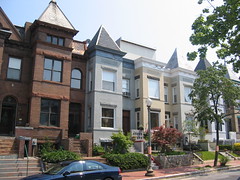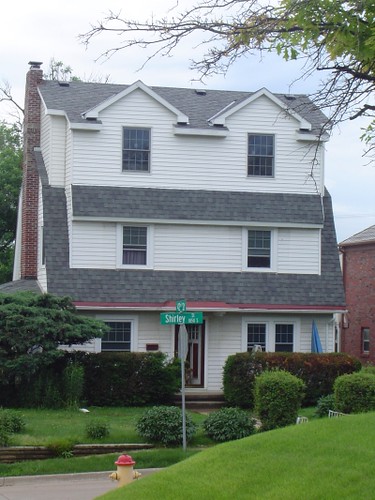Really unsympathetic third floor addition, Bloomingdale neighborhood

Really unsympathetic third floor addition, Bloomingdale neighborhood
Originally uploaded by rllayman.
Does Bloomingdale need to become a historic district to protect the integrity of its housing stock?
I happened to be in the Bloomingdale neighborhood Saturday and saw these historically and aesthetically insensitive additions (one could call it butchering) to these beautiful townhouses. Part of what makes the neighborhood, centered around 1st St, NW so beautiful are the consistent rows of turreted houses. We are under threat of losing this if the city's and neighbor's are not vigilent. Where's the HRPB and the Office of Planning on this one?
I'm not against building additions and added density (indeed we need more people if we want to have more streetlife, better transit service, better retail, a higher tax base, etc.), but just in a way that doesn't butcher the aesthetic and design integrity of what was meant as a coherent ensemble.
My response:
As you should know, HPRB/OP are not proactive on this issue. But nothing in DC law really allows them to be. Only historic districts have design review as a matter of law, and in historic districts zoning is trumped by historic preservation law.
The additions you photographed result from the fact that the typical height of the residential buildings in our historic (designated or eligible for designation) rowhouse neighborhoods and the maximum height allowed by zoning are not congruent.
I doubt that there is a movement to make Bloomingdale a historic district. It's hard. The HPO hasn't been funding such efforts for awhile. And the amount of social capital and community organizing skill required to make it happen in the current political environment is considerable and the numbers of skilled people able to pull this off are few.
IMO, and I have written about this extensively, the DCHPO is behind the times in terms of responding to the changed environment, and in "schooling" neighborhood groups in how to pursue designation in light of the changes.
Another thing we forget is that often, in these kinds of neighborhoods, opposition to historic designation is fomented, if not organized, by pro-development forces such as community development corporations. And the help provided to the pro-preservationists is pretty meager.
OTOH, Ann Hargrove appears to be successful in this changed environment, in moving along the proposal for a Washington Heights (although the demographics for that area are considerably different than from Bloomingdale, Brookland, or H Street NE). OTOH/2, an effort failed a couple years ago in Armsleigh Park, in the greater Tenleytown area. OTOH/3, I hear that the effort in Chevy Chase is chugging along.
 Another unsympathetic third floor addition, Bloomingdale neighborhood. Photo by Steve Pinkus.
Another unsympathetic third floor addition, Bloomingdale neighborhood. Photo by Steve Pinkus. Bloomingdale Rowhouses on First Street NW. Photo taken in April while on a CulturalTourismDC sponsored walking tour of the neighborhood. (Richard Layman)
Bloomingdale Rowhouses on First Street NW. Photo taken in April while on a CulturalTourismDC sponsored walking tour of the neighborhood. (Richard Layman)This can happen here... (Photo by Redd Omaha, Omaha, Nebraska.)

Index Keywords: historic-preservation



0 Comments:
Post a Comment
<< Home